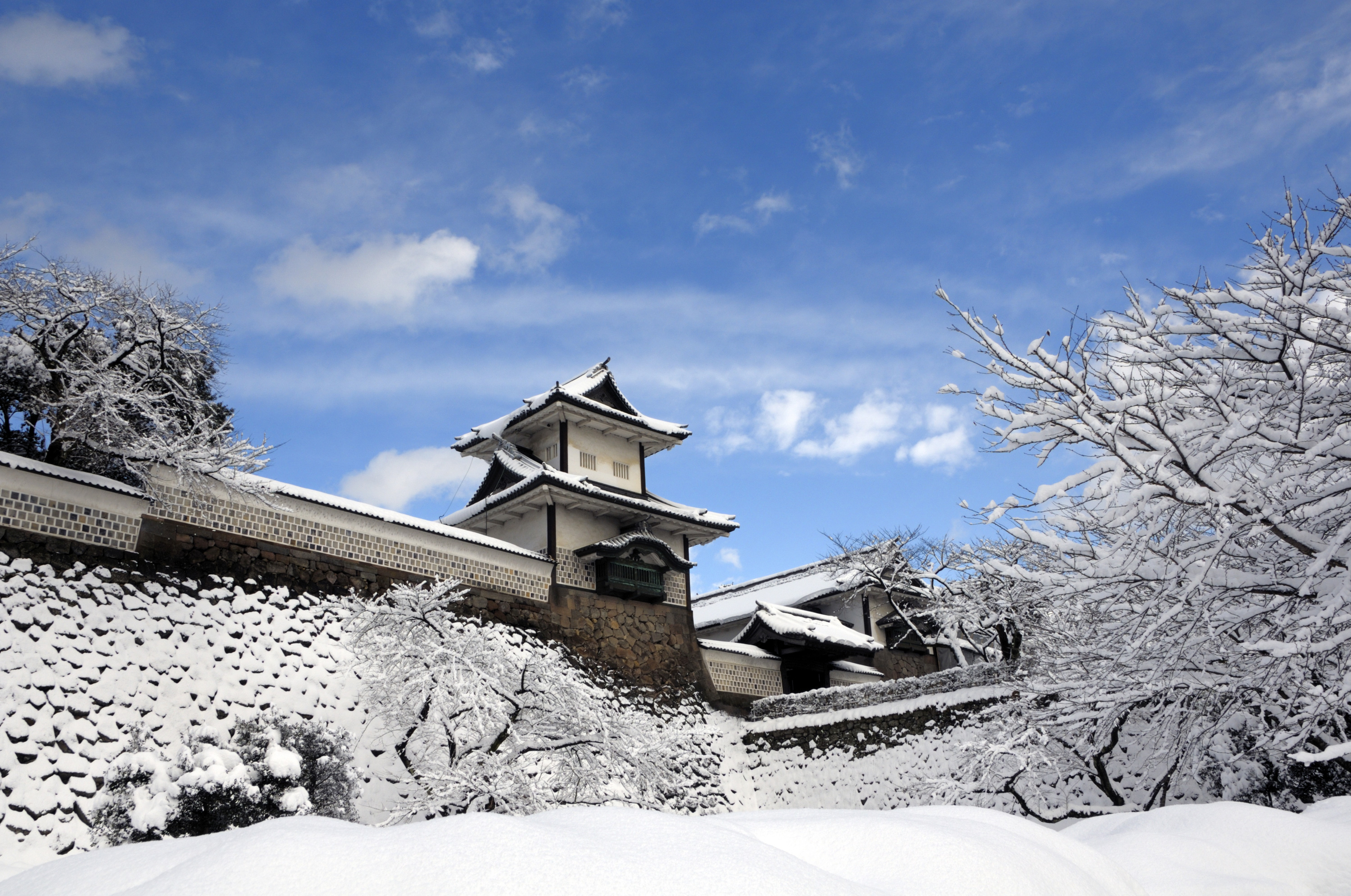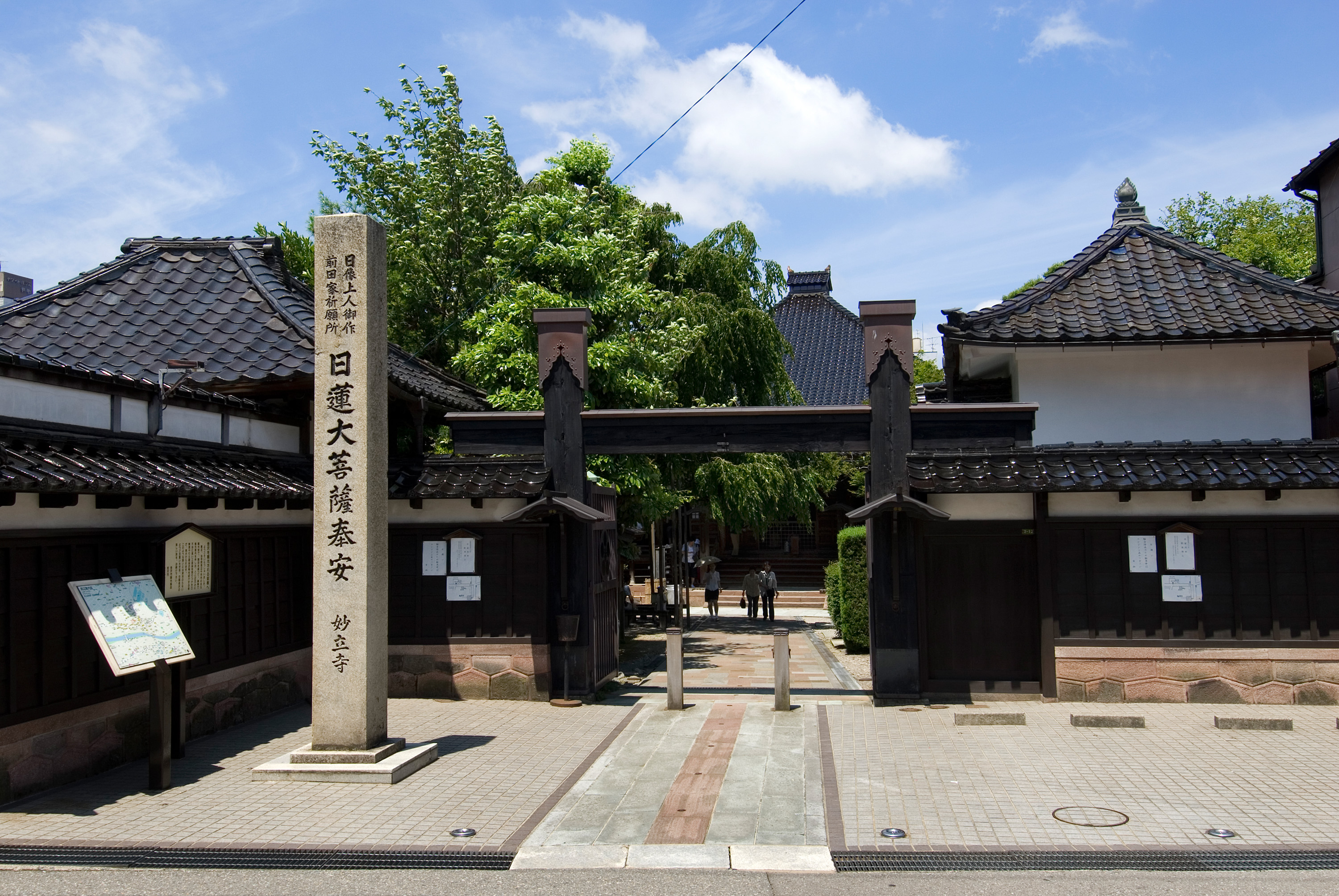 Tour Information Tour Information
|
|
|
 Photo credit: Kanazawa City
Photo credit: Kanazawa City
|
The shrine that enshrines Maeda Toshiie was
moved to the present location in 1873. The
main gate is a peculiar mix of traditional
Japanese, Chinese, and European religious
architectural elements. This gate, which was
designated as Japan's important cultural
assets, was completed in 1875. One of the
highlights of Oyama Shrine is the garden in
round-the-pond style with an artificial island
and bridge in the images of old musical
instruments, such as the biwa (Japanese shortnecked
fretted lute). |
|
|
|
 Photo credit: Kanazawa City
Photo credit: Kanazawa City
|
The Omi-cho Market was established about the
middle of the 18th century. Since then, it has
been supporting the gastronomic culture of
Kanazawa for more than 280 years. There are
as many as 170 stores including a large
number of fish stores that sell fresh fish and
seafood caught in the Sea of Japan, vegetable
stores that sell unique Kaga vegetables, fruit
stores, dried food and marine product stores,
grocery stores, and clothing stores besides
restaurants.
Crabs, yellowtail, and small shrimp from the
Sea of Japan that are sold around November, in particular, are highly evaluated in
Japan. The market is crowded with residents and tourists during the season.
More than 10 tenants including restaurants and drugstores are in operation in the
redevelopment building named Omi-cho Ichibakan.
|
|
|
|
 Photo credit: Kanazawa City
Photo credit: Kanazawa City
|
Kenrokuen Garden is a beautiful Japanese
garden with an area of 11.4 hectares located
on the heights of the central part of Kanazawa
and next to Kanazawa Castle. The Maeda
family, who ruled the Kaga Clan (the present
Ishikawa and Toyama areas) in feudal times,
maintained the garden from generation to
generation. From its scale and beauty, it is
regarded as one of the most beautiful feudal
lords' gardens in Japan.
|
|
Kenrokuen Garden has a big artificial pond,
and hills and houses are dotted in the garden.
Visitors can appreciate the whole, dropping in at them. The big pond called
"Kasumigaike" was compared to an open sea, and an island, on which an ageless hermit
with miraculous power was believed to live, was constructed in the pond in hope of the
long life and eternal prosperity of the lord. Kenrokuen, which means "having six factors",
was given the name because of the six attributes that bring out the perfect landscape
of the garden: spaciousness, tranquility, artifice, antiquity, water cources, and
magnificent view from the garden.
There is a stone lantern designed in the image of the Japanese koto (harp) by the pond,
which becomes the symbol of Kenrokuen Garden. There is a fountain created using the
natural pressure of water flowing from the higher pond.
Visitors can enjoy the beauty of the flowers and trees, such as plum and cherry
blossoms in spring, azaleas and irises early in summer, and colorful red and yellow
leaves in autumn. Besides, visitors will have a glorious view of seasonal natural beauty
including the snow-covered landscape with yukitsuri (literally means snow hanging),
which is performed for approximately one month from November 1 every year. This is a
method of protecting the branches of the pine trees in the garden with ropes attached
in a conical array to the trees in order to prevent the branches from breaking.
|
|
|
|
 Photo credit: Kanazawa City
Photo credit: Kanazawa City
|
In 1583, Lord Maeda Toshiie, who was
Toyotomi Hideyoshi's first retainer, moved to
Kanazawa. The Maeda family resided in
Kanazawa Castle and governed the Kaga Clan
(the present Ishikawa and Toyama areas) for
more than 280 years henceforth. The castle
tower was burned down by a fire in the past
and has not been rebuilt, but other fortress
buildings were reconstructed repeatedly. The
Ishikawamon Gate, which was rebuilt in 1788,
and the Sanjikken Nagaya (50-yard-long
warehouse), which was rebuilt in 1858, still
remain. Both of them have been designated as
Japan's important cultural assets.
|
|
The place was used as a base of the Japanese army. Later, Kanazawa University used it
as a campus. The place was repaired in 1996, and the Hishiyagura (diamond-shaped
turret), Gojikken Nagaya (90-yard-long warehouse), and Hashizumemon Tsuzuki Yagura
(turret protecting the nearby gate) were restored and the park opened.
In the time of the Maeda family, moats surrounded Kanazawa Castle. The castle had a
fort function with loopholes for matchlocks on the outer wall to defend the castle from
enemies. The beautiful white tiles that grace the roof are weathered lead and the wall is
made of white mortar with flat tiles attached to it.
The stone walls vary in type with each place, and it is apparent that the stonewalls were
built in separate periods. The stone walls include those built more than 400 years ago.
|
|
|
|
 Photo credit: Kanazawa City
Photo credit: Kanazawa City
|
The 21st Century Museum of Contemporary
Art, Kanazawa as a new-style art museum
different in image from conventional art
museums was opened in October 2004.
This art museum is round in shape as if it were
the sight of a UFO that has touched down, all
the walls are made of glass, and the building
has five gates, which looks like a part opened
in all street directions.
|
|
The museum exhibits experiment-type contemporary arts that visitors can touch or sit
on, and includes zones where visitors can enter free. Both adults and children can
experience an excited time in the museum. Some of the highlights of the museum are
commissioned works, i.e., arts integrated with the building structure. These arts include
a work that enables visitors to feel as if they stand on the bottom of a swimming pool,
the surface of a wall colored with flowers gathered from the suburbs of Kanazawa, and
a room with an opening on the ceiling through which visitors can see the changes of
the sky.
Olafur Eliasson's works were installed in the square in March 2010.
The museum's shop offers a wide variety of products, such as original items in the
image of the museum, accessories, and selected goods.
|
|
|
|
 Photo credit: Kanazawa City
Photo credit: Kanazawa City
|
Chaya is a traditional place of feasts and
entertainment, where geisha (traditional female
Japanese entertainers) have been entertaining
people by performing dances and playing
Japanese traditional musical instruments since
the Edo period. The central part of Kanazawa
was dotted with a number of chaya houses in
the past. These chaya houses were moved into
four districts distant from the central part in
1820. The largest one of the chaya districts in
Kanazawa is the Higashi Chaya district.
|
|
The construction of two-story houses except chaya houses was prohibited in the Edo
period. A chaya house is characterized with a beautiful lattice called "kimusuko" on the
outer side of the first floor and Japanese-style guestrooms located on the second floor.
When you enter back streets, you will soon find a maze of continuous alleys. The
historical rows of this teahouse town along with Kyoto's Gion and Kanazawa's Kazuemachi
have been designated as Japan's cultural assets. There are no other chaya
districts designated as Japan's cultural assets. The district includes facilities where you
can see the interior of a chaya house that was built 180 years ago. Besides, quite a few
old buildings have been renewed into restaurants, teahouses, and souvenir shops. It
takes three minutes on foot to the bank of the Asano River from the Higashi Chaya
district. The Higashi Chaya district and Asano river area are places where you can enjoy
strolling and become acquainted with Japanese history and culture. Kanazawa City
Tourism Association holds a geisha performance show in the three chaya districts of
the city every Saturday.
|
|
|
Ninjya-dera Temple (Myoryuji Temple)
http://www.myouryuji.or.jp/en.html
(12min by taxi from the conference venue)
* All visitors need to apply for official tour provided by Myoryuji (need reservation)
|
|
 Photo credit: Kanazawa City
Photo credit: Kanazawa City
|
Myoryuji Temple was built as a prayer place of
the Kaga Domain soon after Lord Maeda
Toshiie, founder of the Kaga Domain, moved to
Kanazawa Castle. Later, in preparation for an
emergency attack of the central government
(Tokugawa Shogunate), the Maeda family
considered the temples in Tera-machi as a
shield. Then the family added a number of
functions to Myoryuji Temple so that it would
work as a lookout post and fort. To
countermeasure the invasion of enemies,
Myoryuji Temple is provided with a variety of
mechanisms. That is why this temple is also
called Ninja Temple.
|
|
|
|
 MAP MAP
|
|
|

